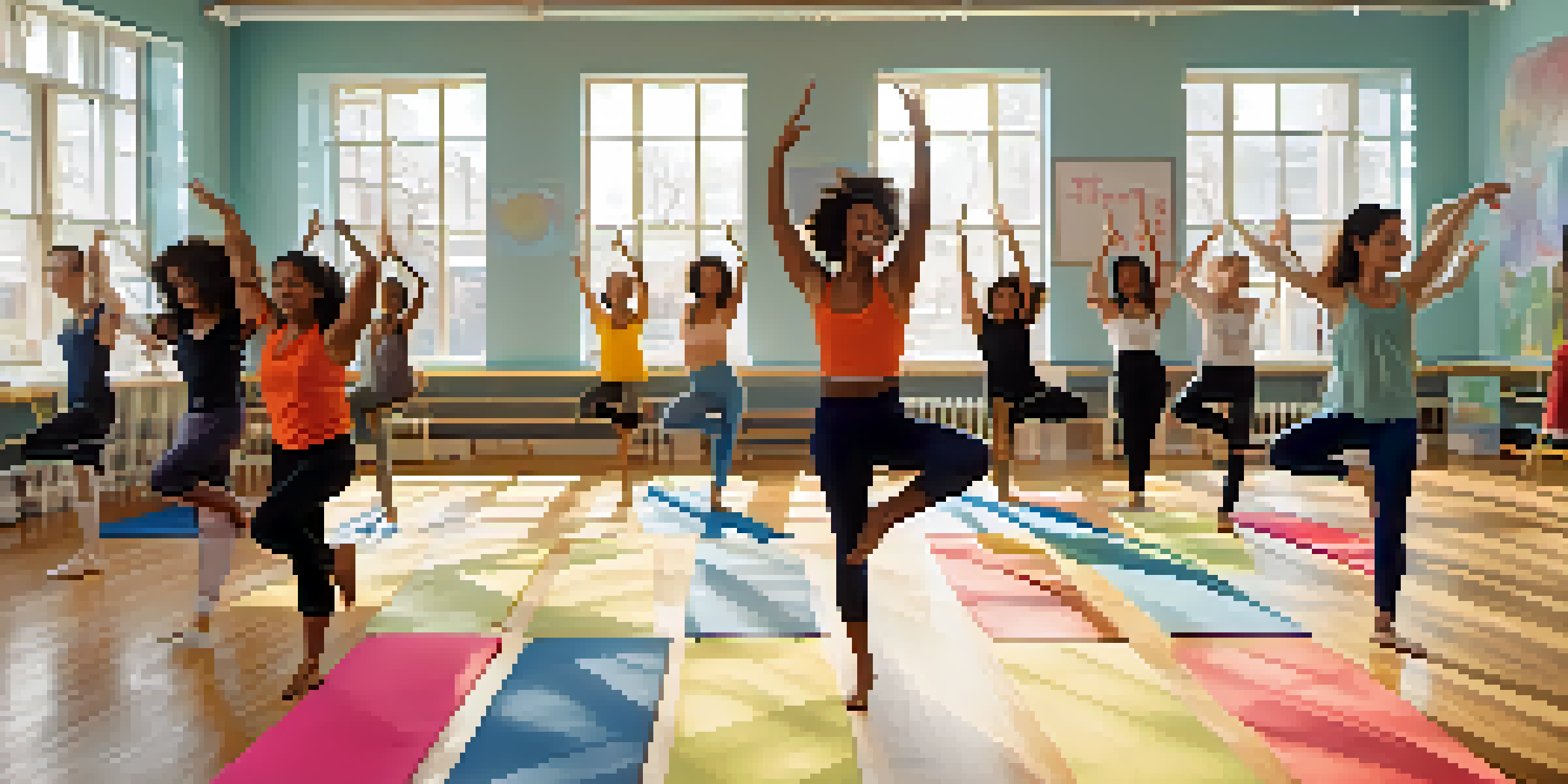Implementing Dance Therapy in School Programs for Students

Understanding Dance Therapy and Its Benefits for Students
Dance therapy, also known as dance/movement therapy (DMT), is a therapeutic approach that uses movement to promote emotional, cognitive, and physical well-being. It encourages students to express themselves through dance, providing a unique outlet for emotions that might be difficult to articulate. This form of therapy can be particularly beneficial for children facing anxiety, depression, or trauma, as it enables them to communicate and process feelings in a creative manner.
Dance is the hidden language of the soul.
One of the key benefits of dance therapy is its ability to enhance self-esteem and body awareness. As students engage in movement, they learn to appreciate their bodies and develop a greater sense of confidence. This can be particularly impactful in a school setting, where self-image issues often arise. By participating in dance therapy, students can cultivate a positive body image and learn to celebrate their individuality.
Moreover, dance therapy fosters social skills and teamwork. In group sessions, students must collaborate and communicate with one another, which can improve their interpersonal relationships. This not only creates a supportive environment but also helps students develop empathy and understanding for their peers, further enriching the school community.
Key Components for Successful Dance Therapy Programs
To create an effective dance therapy program in schools, it’s essential to have trained professionals leading the sessions. Certified dance therapists are equipped with the skills to ensure that the experience is both safe and therapeutic. They understand the nuances of movement and emotional expression, allowing them to tailor sessions to meet the specific needs of students.

Another crucial component is the establishment of a safe and welcoming environment. Students should feel comfortable expressing themselves without fear of judgment. This can be achieved by creating a space where students can explore their movements freely and share their experiences openly. When students feel secure, they are more likely to engage fully in the therapeutic process.
Dance Therapy Boosts Student Well-Being
This therapeutic approach helps students express emotions, enhancing their emotional, cognitive, and physical health.
Lastly, integrating dance therapy with other school programs can amplify its benefits. Collaborating with teachers and counselors to align dance therapy with existing curricula can enhance its impact. For instance, using dance to explore themes in literature or history can create a deeper understanding of the material while also fostering emotional growth.
Engaging Students: Activities in Dance Therapy
In dance therapy sessions, activities can vary widely, but they all aim to engage students creatively. Simple exercises such as mirroring movements can help students develop a sense of connection with each other. By mimicking a partner's movements, they not only build trust but also enhance their non-verbal communication skills, which are crucial in forming relationships.
Movement is a medicine for creating change in a person's physical, emotional, and mental states.
Another engaging activity is improvisational dance, where students are encouraged to express their current emotions through movement. This allows them to tap into their feelings and release pent-up energy or stress. By making the experience personal, students can process their emotions in a healthy way, which can be incredibly liberating.
Group choreography can also be a fun and collaborative way to foster social bonds. Students work together to create a dance, allowing them to share ideas and compromise. This experience cultivates teamwork and helps students learn to appreciate the strengths and perspectives of their peers.
Overcoming Challenges in Implementation
Implementing dance therapy in schools can come with its set of challenges. One common hurdle is securing funding for the program. Schools often operate on tight budgets, making it difficult to allocate resources for specialized therapy. However, seeking grants or community partnerships can be an effective way to overcome this barrier and ensure the program's sustainability.
Another challenge can be gaining buy-in from parents and educators. Some may be skeptical about the benefits of dance therapy. Educating stakeholders about the positive outcomes, such as improved mental health and enhanced social skills, can help alleviate concerns. Hosting workshops or informational sessions can encourage open dialogue and foster support for the program.
Successful Programs Require Support
Effective dance therapy programs thrive when led by trained professionals in a safe environment, integrated with existing curricula.
Finally, ensuring accessibility for all students is vital. Dance therapy should be inclusive and adaptable to meet the diverse needs of students, including those with disabilities. By addressing these challenges thoughtfully, schools can create a program that truly benefits every student.
Success Stories: Dance Therapy in Action
There are numerous success stories that highlight the transformative power of dance therapy in schools. For instance, a middle school in Chicago implemented a dance therapy program after noticing an increase in students exhibiting anxiety. Over the course of the year, teachers reported significant improvements in students' emotional regulation and social interactions, showcasing the program's impact on their overall well-being.
In another case, a high school in Los Angeles used dance therapy to help students cope with trauma after a community crisis. The program facilitated healing through movement, allowing students to express their feelings and find solace in a supportive environment. Feedback from participants indicated that dance therapy helped them process their experiences, ultimately leading to greater resilience.
These stories illustrate that dance therapy is not just a creative outlet; it can be a powerful tool for emotional healing. As more schools recognize its potential, we can expect to see an increasing number of success stories that inspire further integration of dance therapy into educational settings.
Measuring the Impact of Dance Therapy Programs
Evaluating the effectiveness of dance therapy programs is essential to understand their impact on students. Schools can employ various methods, such as surveys and interviews, to gather feedback from students and teachers. By assessing changes in behavior, emotional well-being, and academic performance, educators can gain valuable insights into the program's success.
Additionally, tracking attendance and participation rates can provide quantitative data to support the program's value. High engagement levels often indicate that students find the sessions beneficial and enjoyable. This data can be instrumental in securing continued funding and support for the program.
Growing Demand for Dance Therapy
As mental health awareness increases, more schools are likely to adopt dance therapy to support students' emotional development.
Finally, sharing success stories and testimonials can help demonstrate the program's impact on the school community. Highlighting individual journeys and collective achievements can inspire others to consider the integration of dance therapy, creating a ripple effect that promotes mental health awareness in schools.
The Future of Dance Therapy in Education
As awareness of mental health issues in children continues to grow, the role of dance therapy in education is likely to expand. More schools are beginning to recognize the importance of holistic approaches to student well-being, integrating art forms like dance into their mental health strategies. This shift signifies a broader understanding that emotional health is just as important as academic success.
In the future, we may see more collaboration between dance therapists and educational institutions, leading to tailored programs that address the unique needs of students. Innovations in technology could also play a part, with virtual dance therapy sessions becoming a viable option for reaching students who may not have access to in-person programs.

Ultimately, the future of dance therapy in schools looks promising. As more students benefit from these programs, we can hope to foster a generation that is not only more emotionally aware but also equipped with the tools to navigate their feelings in healthy, constructive ways.